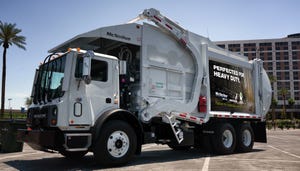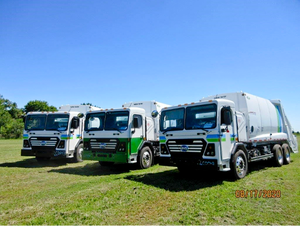Lone Star on the Recycling Frontier
August 1, 1997
Nancy Nevil
Recycling collection was taking its toll on the city of Plano, Texas. Toiling 10 hours a day, collecting high tonnages, workers were subject to significant injuries. To counteract high workers' compensation costs and to increase collection efficiencies, Plano began to investigate automating their recycling collection.
Innovation is no stranger to Plano which can list a string of "first in Texas" attributes after its name. For example, it was the first to establish a household hazardous waste reuse facility for the general public and the first to operate a composting facility. It also was one of the first cities to provide curbside recycling collection.
The city, which provides residential collection to 52,278 single-family households, already is experienced in automation. In the last five years, it has converted from twice-weekly trash collection using plastic bags to once-weekly trash collection using 95-gallon carts, recyclables with 18-gallon totes and landscape waste with biodegradable bags or manageable piles.
Plano collects recyclables in a two-sort stream (commingled and newspaper/magazines) using a Crane Carrier with a Dempster Recycle-Pak body. The material is taken to the Brown-ing-Ferris Industries Inc. (Houston) Recyclery in Plano for processing.
Touch And Go The city decided to test a semi-automated cart system to collect its recyclables, retrofitting existing trucks.
Several problems occurred during the pilot program. First, to modify the trucks, the city had to remove the front support of the two-sort bin, which caused the entire assembly to flex during the dump cycle, resulting in major and minor cracks to the bin structure.
To solve this problem, the equipment services department used an A.R.E./Otto (Charlotte, N.C.) face plate and completely redesigned and fabricated a system which was placed on the bodies. The new system is 250 pounds lighter, causing less strain on the hydraulic system and less fatigue and stress on the main supports and welds. It handles 32- or 68-gallon containers and doesn't flex while dumping.
This heavy duty unit latches to the cart, and uses two air cylinders which becomes a safety feature if one of the cylinders fails while the cart is in the dump position.
The pilot used 32-gallon containers distributed to 8,000 homes. This size was chosen in anticipation of resistance to a larger container by residents with limited garage storage or alley space.
Residents were surveyed five months into the pilot program; 32 percent reported insufficient capacity with weekly collection. A majority of the rest of the participants said weekly collection would be enough. The average weekly set-out rate increased from 48 to 68 percent.
City-wide implementation of this program would have increased collection costs significantly; route size would have to be reduced, requiring more trucks and personnel. In addition, the 32-gallon cart proved to be less efficient because certain items would not empty during the dump cycle.
Plano replaced the 32-gallon with 68-gallon carts for 1,500 customers. Those requiring weekly collection dropped from 77 to 40 percent with 25 percent requiring twice monthly collection, and 7 percent needing monthly collection.
However, the weekly set-out rate for those with 68-gallon carts was 52 percent compared to 68 percent for customers with the 32-gallon carts. Consequently, collection productivity was improved significantly.
Measuring Results The pilot program's impact on participation and volumes collected was impressive. For example, 29 percent of the participants started recycling for the first time. Plano attributed this to the convenience of the automated system.
Also, commingled tonnages in-creased an average of 14 percent, and newspaper tonnages increased an average of 8 percent.
However, the amount of per weekly set-out decreased from 22.16 pounds to 16.59 pounds which coincides with the increased frequency of set-out and the insufficient capacity.
With the 68-gallon cart, the average participant recycles 24.63 pounds per week (18.94 pounds of newspaper and 5.69 pounds of commingled material). The 68-gallon cart also is more efficient and enables the city to add materials in the future.
Projecting volume increases city-wide would increase diversion from its current 15 percent to 22 percent. Combined with the tonnages from the landscape waste collection and composting program, the city could reach 36 percent diversion, which would save $75,265 in disposal costs.
A ton-for-ton cost avoidance wouldn't be realized, however, since Plano is a member of a regional disposal district and pays a disposal cost based on the percentage of tonnages delivered. Revenue from additional recycling tonnages based on this year's markets would increase by $49,028. The previous year's recyclables would have brought in an additional $293,354.
Using the decrease in workers' compensation it experienced with the conversion to semi-automated trash collection, the city would save $60,875. Obviously, as workers compensation costs reduce, so do the number of man-hours lost due to limited duty or no duty. This would result in an additional $25,631 savings in back-up personnel costs.
On the other side of the balance sheet, the city would have to buy the split carts (using a 10-year funding period) and would have to pay the approximate $2,500 retrofitting cost per truck. Plus, increased participation and volumes would require two new routes.
The cost of providing semi-automated collection city-wide would increase the solid waste budget by $356,522 annually (see chart on page 35). However, savings and increased revenue would offset some of these expenditures.
The program's incremental cost of $145,723 represents a minimal increase compared to the benefits of a 7 percent increase in diversion, improved working conditions, and, most importantly, more satisfied customers.
Over the next few months, the city will test split carts and will evaluate its options in preparation for expansion of the program next fiscal year.
Number and types of refuse trucks: 16 automated refuse. Crane Carrier with Heil Rapid Rail (24 cubic yards).14 Crane Carrier with Dempster Recycle Pak (33 cubic yards). 8 rearloaders for landscape waste and special collections. Crane Carrier with Pakmor 20 cubic yards. 1 boom truck.
Containers: Refuse: 95-gallon, Otto and Rehrig-Pacific. Recycling: 32- & 64-gallon, Otto.
Customers: 52,411 single-family households.Employees: 59.
Service area: fast-growing metropolitan suburb of Dallas.
Services: Recycling; construction and demolotion debris removal and/or recycling; business and industry (commercial waste collection), appliance recycling; household hazardous waste collection.
Local tipping fees: $24.71 per ton at transfer stations and landfills.
You May Also Like


